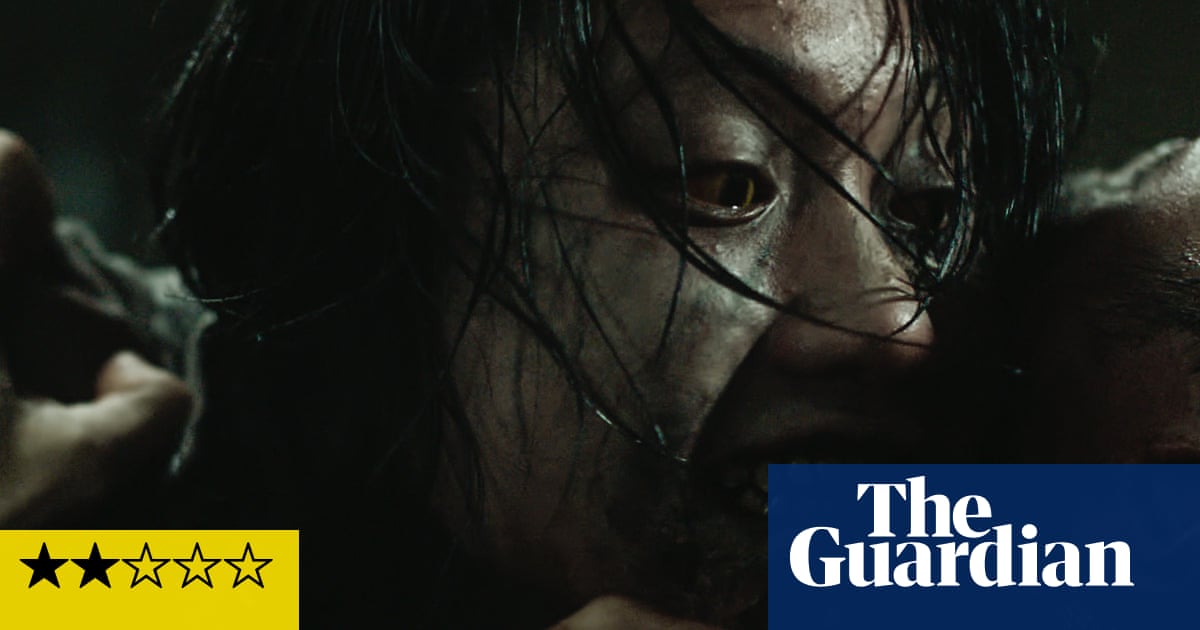
The Ikon Gallery in Birmingham is an old Victorian school that was turned inside out and filled with new modernist interiors in the late 1990s. It looks to the untrained eye like a place of dusty classrooms and tiled corridors, but inside you’ll find glass stairwells and white cube gallery spaces. Around you, nearly everything is modern. Ikon stands in one of the first New Labour urban regeneration showpieces – Brindleyplace, all chain cafes, pristine lawns and squares, and canalside office blocks. It is privately secured and patrolled, managed apart from the rest of the city. Nothing is allowed to go wrong; nothing is quite what it seems; nothing is real. It’s an appropriately uneasy place for Horror in the Modernist Block, a show aiming to explore the perhaps obscure links between modern architecture and horror.
Horror is generally about the irrational. It is a matter of things that do not exist – ghosts, vampires, zombies – and about how the brain manufactures terrors for itself in situations where you’re usually entirely safe. It’s also, often, about the past: the revenants and spectres left over from an earlier, apparently less enlightened age. Accordingly, a “haunted house” is usually not cubic and made of steel and concrete. But terror has certainly happened in modern buildings. In fact, the terms used to be all-but-synonymous for tabloid headline writers who, from the 70s to 90s, filled their pages with stories about ghastly scenes of murder and social dysfunction in high-rise social housing estates, and branded London’s Trellick Tower the Tower of Terror (flats there now sell for more than £1m).
But merely being frightened by things is not quite the same as horror, and there was usually nothing particularly supernatural about tabloid crime stories set in “sink estates” – as if the architecture does not lend itself to the mindset of real horror. This is not coincidental. The reason why a “haunted house” tends to be old and gothic isn’t just the fact that its floorboards might have a satisfyingly eerie creek, but because there is so much unseen in a Victorian house. Originally, every surface will have been covered in doilies, rugs, throws and carpets, and everything from table legs to dinner services will have been richly ornamented; moreover, there were places you weren’t meant to see, from the servants’ quarters below to half-forgotten attics within steep pitched roofs.
In the 1920s, all that was suddenly swept away, for a kind of house that would be a rational “machine for living in”, with no past, and a present without dust, dirt or dark corners. The sentimentality, superstitious religiosity and brutal inequality of the 19th-century city would be swept away in favour of logical, egalitarian, clear-eyed cities. Walter Benjamin praised this new modernist architecture – the right-angled, glassy, clean modernist houses of Le Corbusier or Mies van der Rohe – for constructing places where you could not leave traces. That is, these were houses without ghosts.
Horror in the Modernist Block showcases artists examining the ways in which these buildings can be eerie and alienating. For instance, in Kihlberg and Henry’s film Slow Violence or artist NT’s film BRUTAL, Birmingham’s high-rise estates and new luxury living enclaves are looming and sinister; Firenze Lai’s paintings stress the confining, claustrophobic nature of Hong Kong’s high-rise housing; Ho Tzu Nyen’s video The Cloud of Unknowing stages the ghostly invasion of a Singapore public housing estate and the demonic possession of its residents on the eve of its demolition; and in Maria Taniguchi’s Mies 421, the opulent marble and chrome volumes of Mies van der Rohe’s Barcelona Pavilion are rendered depopulated and sinister. Arguably, all of these have their roots in the way that some horror film directors, not satisfied with the tired tropes of gothic mansions, have found horror in concrete.
Probably the first horror films to explore modernist spaces as the scenes of appalling crimes were the Italian giallo slashers of the 1970s and early 1980s. Made during the political chaos of the “Years of Lead”, these films frequently took place in the high-modernist interiors of executive apartment blocks or private houses in the rich cities of northern Italy. The lurid reds and oranges of Verner Panton furniture, and the sharp edges of glass coffee tables, became a new vocabulary of horror, places where the human body was sliced up by the hard lines of modern design.
In giallo films, violence is treated with the same fastidious attention to detail as the layout of a Bauhaus home – something that makes them perfect Instagram fodder. The most dramatic example of giallo modernism comes in Dario Argento’s 1982 film Tenebrae, which mostly takes place in a remarkably unnerving brutalist house: the Villa Ronconi in the suburbs of Rome, designed by Saverio Busiri Vici in the early 70s. Its concrete grid is organised in such a complex fashion that inside and outside are completely scrambled, an apt setting for this story of a media-inspired serial killer.
The great director of modernist horror is David Cronenberg. His early features consistently used the brutalist buildings of his native Canada as the offices for sinister laboratories and corporations undertaking various appalling experiments. In Shivers, a parasitic STD is let loose on the residents of Nun’s Island, an impeccably rational, Mies van der Rohe-designed steel and glass grid of luxury flats in Montreal; in The Brood, experiments that will lead to a woman producing murderous mutant children take place in the secluded, forested Somafree Institute of Psychoplasmics (filmed at the Kortright Centre for Conservation, outside Toronto); and in Scanners, psychic adolescents are trained to explode their enemies’ heads at the offices of ConSec, which is actually the Futur Electronique Building on the outskirts of Montreal, an enigmatic brutalist block surrounded by nothing.
For Cronenberg, a peculiar if orthodox Freudian, these modernist spaces are all attempts to make rational creatures out of human beings whose minds and bodies are ungovernable and terrifying. His scientists’ attempts to create logic only release chaos.
Any depiction of horror in the modernist block, however, has to reckon with Candyman, Bernard Rose’s audacious horror classic on race and class in Chicago through the tale of a mythical, supernatural killer. Candyman has surely launched a thousand PhD theses – appropriately, for a film about academics – but at the heart of it is a return of the repressed in two modernist housing estates.
Graduate student Helen Lyle lives in a gorgeous high-rise flat in Lincoln Village (this is in fact Carl Sandburg Village, which, like its fictional equivalent, is a 1960s social housing project that was privatised and turned into condominiums). She becomes obsessed with the urban legend of the Candyman: the murderous ghost of Daniel Robitaille, a black painter who was tortured and lynched for forming a relationship with a white woman in the 1890s. He was killed, we are told, on the future site of Cabrini-Green Homes, an estate of red-brick and concrete grids just outside the city centre that was by then the most notorious modernist failure in the US (opened in 1957, the buildings were demolished in the 00s, and replaced with private housing). One of these high-rise estates, we are shown, can be viewed from the windows of the other.
Long before brutalist buildings became the objects of niche tourism, Helen goes on queasily voyeuristic excursions to Cabrini-Green to document the horrifically dilapidated towers, and their devastated surroundings – startlingly close to the shiny Miesian glass skyscrapers of the city centre – to take photographs and collect stories. Finding herself in what residents claim is the home of the Candyman, she is in an appalling refraction of her own spacious modernist condo, coated in graffiti, riddled with vermin, with its glass windows obscured by chicken wire. Outside Lincoln Village are tree-lined paths, benches and elegant 60s light-fittings, all covetable by today’s modernism enthusiasts; outside Cabrini-Green are parking lots, freeways and a towering pile of waste. They’re the same place, subjected to a radically different fate.
Unlike the accounts of modernist housing that see it as something intrinsically alienating and sinister, Candyman’s satire is not aimed at the buildings; as the contrast shows, they can be whatever we want them to be. Rather, it is a ferocious attack on the ways in which architecture is wrapped up in the US’s monstrous inequalities of race and class. The legacies of slavery and what is not so much a legacy as a present of stark segregation continue to haunt the modernist blocks because their horrors have never actually ended. The two high-rise estates in the film are a perfect synecdoche for a system that can make a utopia and dystopia out of exactly the same design, depending on what class or race the residents were born into.
Here is the true irrationality, and the Candyman is an avenging, silky-voiced angel floating across both sides of the tracks. On the other side of the office blocks of Brindleyplace, visible from the Ikon Gallery, are the high-rise estates of Ladywood, one of the poorest places in the UK. Just like Helen Lyle, you can stare from the windows of one towards the other. As the Candyman trills to her: “I am the writing on the wall.”
Horror in the Modernist Block is at Ikon Gallery, Birmingham, until 1 May.












